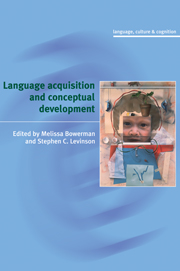Book contents
- Frontmatter
- Contents
- Preface
- Introduction
- Part 1 Foundational issues
- Part 2 Constraints on word learning?
- Part 3 Entities, individuation, and quantification
- 7 Whorf versus continuity theorists: bringing data to bear on the debate
- 8 Individuation, relativity, and early word learning
- 9 Grammatical categories and the development of classification preferences: a comparative approach
- 10 Person in the language of singletons, siblings, and twins
- 11 Early representations for all, each, and their counterparts in Mandarin Chinese and Portuguese
- 12 Children's weak interpretations of universally quantified questions
- Part 4 Relational concepts in form–function mapping
- Author index
- Subject index
10 - Person in the language of singletons, siblings, and twins
Published online by Cambridge University Press: 26 January 2010
- Frontmatter
- Contents
- Preface
- Introduction
- Part 1 Foundational issues
- Part 2 Constraints on word learning?
- Part 3 Entities, individuation, and quantification
- 7 Whorf versus continuity theorists: bringing data to bear on the debate
- 8 Individuation, relativity, and early word learning
- 9 Grammatical categories and the development of classification preferences: a comparative approach
- 10 Person in the language of singletons, siblings, and twins
- 11 Early representations for all, each, and their counterparts in Mandarin Chinese and Portuguese
- 12 Children's weak interpretations of universally quantified questions
- Part 4 Relational concepts in form–function mapping
- Author index
- Subject index
Summary
Introduction
Many of the chapters in this book are concerned with the child's grappling with concepts of the nature of countable objects, or the very mechanisms of counting themselves or of the logical and spatial relations between objects: naive physics, geometry, logic and maths. But in this chapter we turn to an area of much greater concern to the child him- or herself: the realm of person identification. Clearly person identification is the precondition to socio-emotional attachment, and indeed meaningful human social life.
What can we learn about children's conceptions of the person by looking at early language? At first sight perhaps not much. Person identification is in place long before the beginnings of language. Moreover, there are some particular, intrinsically linguistic difficulties with person reference - namely the fact that proper names are replaced by pronouns in first and second persons (at least in the familiar European languages). The tendency for children's first references to self to use their own names or nicknames has been well documented (see e.g. Tanz 1980: ch. 4 for review; Chiat 1986), and their difficulties with pronouns are natural given the way in which their reference shifts according to who is speaking. But the data in this chapter suggest that more can be at stake than mere linguistic difficulty: this becomes especially evident in a special kind of self-reference to be found occasionally among twins.
- Type
- Chapter
- Information
- Language Acquisition and Conceptual Development , pp. 284 - 315Publisher: Cambridge University PressPrint publication year: 2001
- 6
- Cited by

